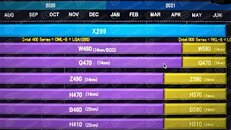Tuesday, October 6th 2020

Intel to Debut 500-series Chipset with Core "Rocket Lake-S," Which Launches Late-Q1 2021?
Intel will debut its 500-series desktop motherboard chipset series with its 11th Gen Core "Rocket Lake-S" desktop processors. A leaked alleged roadmap slide possibly from a presentation targeting an Intel ecosystem partner, reveals that the 500-series chipset will debut no sooner than March 2021, which could also mean "Rocket Lake-S" chips themselves could launch around that time, since Intel tends to launch new processor generations alongside new chipsets that are compatible out of the box. Even the 9th Generation "Coffee Lake Refresh" was accompanied by new Z390 and B365 chipsets. That said, Socket LGA1200 motherboards based on the existing 400-series chipset are expected to be compatible with "Rocket Lake-S," with BIOS updates. 500-series chipset motherboards might also support older 10th Gen Core "Comet Lake-S" processors.
The roadmap slide reveals that "Rocket Lake-S" could debut with strictly client-segment chipsets, such as the Z590 targeting overclockers, H570 targeting premium desktops, B560 targeting mid-range desktops, and H510 for entry-level desktops. Later in April, Intel could debut the Q570 chipset for commercial desktops, and W580 for workstations. What sets the 500-series chipset apart from the 400-series, appears to be a standardization of PCI-Express Gen 4, at least for the main PEG slot. Certain premium 400-series chipset motherboards already come with preparation for PCIe Gen 4 PEG. The "Rocket Lake-S" processor sees the first IPC increase by Intel on the desktop platform in five years, as the 14 nm chips are expected to feature new "Cypress Cove" CPU cores, which are a back-port of "Willow Cove" for the older 14 nm process. The chips could also feature a Gen12 Xe iGPU.
Sources:
HD-Tecnologia, VideoCardz
The roadmap slide reveals that "Rocket Lake-S" could debut with strictly client-segment chipsets, such as the Z590 targeting overclockers, H570 targeting premium desktops, B560 targeting mid-range desktops, and H510 for entry-level desktops. Later in April, Intel could debut the Q570 chipset for commercial desktops, and W580 for workstations. What sets the 500-series chipset apart from the 400-series, appears to be a standardization of PCI-Express Gen 4, at least for the main PEG slot. Certain premium 400-series chipset motherboards already come with preparation for PCIe Gen 4 PEG. The "Rocket Lake-S" processor sees the first IPC increase by Intel on the desktop platform in five years, as the 14 nm chips are expected to feature new "Cypress Cove" CPU cores, which are a back-port of "Willow Cove" for the older 14 nm process. The chips could also feature a Gen12 Xe iGPU.

18 Comments on Intel to Debut 500-series Chipset with Core "Rocket Lake-S," Which Launches Late-Q1 2021?
It uses only big cores, so no atom or hybrid aproach.
Alder Lake is a kind of successor to Lakefield experiment done with 1 Icelake core coupled with a quad Tremont (atom) cluster, wich resulted in a bunch of missing features for the Icelake Core (like SMT and AVX) because afaik all OSes can only work with a hybrid-cpu only when the features are the same, but maybe that changes in the future.
videocardz.com/newz/intel-alder-lake-s-cpu-with-16-cores-and-32-threads-leaks-on-sisoftware-benchmark-website
The SiSoft Sandra screenshot shows 16 Cores and 24 Threads (the 32 Threads headline is likely wrong), wich suggests that somehow the 8 big cores are cappable of SMT, but the 2 little quadcore-clusters don´t.
The 10 time 1.25MB L2 is made of 1 for each (Golden Cove, newer than Tiger Lakes Willow Cove) big core and 1 time for each of the two gracemont (atom) quadcore-clusters.
So somehow the newer hybrid-cpu can use divergent featuresets for big and little, i guess some clever updates where inevitable for that to come real.
cdn.wccftech.com/wp-content/uploads/2018/12/2018_ArchitectureDay_RonakSinghal_FINAL-MB-page-017.jpg
For Gracemont vector performance update is noted, wich could be AVX but that would kind of contradict the mindset of a power and area efficient core design wich the atom line kind of stands for.
We'll just upgrade to Ryzen in the meantime, no harm done.
Exactly how many "++" symbols should we use this time when talking about da Rocket ???
Wouldn't it just be simpler to use 14nm "to the 2nd/3rd/4th etc power" indicators now instead, hahahaha ..:roll:..:D..:fear: